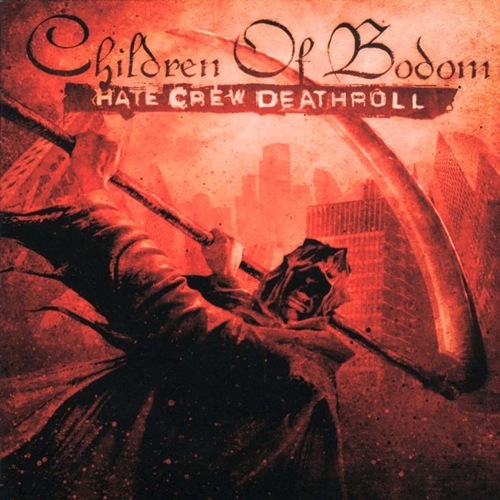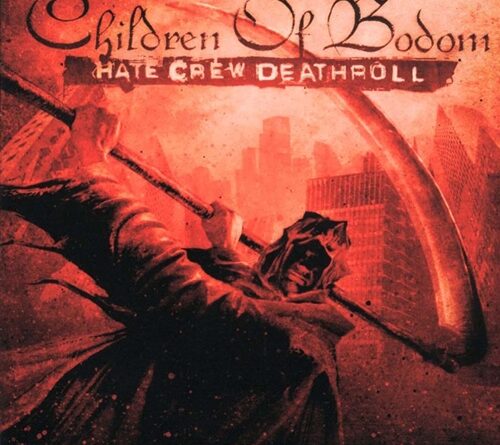HEAVY MUSIC HISTORY: Hate Crew Deathroll – Children Of Bodom
In hindsight, CHILDREN OF BODOM delivered a masterpiece at exactly the right time. Released only six days into January of 2003, Hate Crew Deathroll arrived as the heavy music landscape was going through a major change. Nu-metal had imploded the year before, collapsing beneath the weight of its braggadocio and multiple pairs of enormous trousers, and the way was wide open for more aggressive, “truer” metal to take its place.
In the states, metalcore and the so-called ‘New Wave Of American Heavy Metal’ were gathering steam, with KILLSWITCH ENGAGE leading an army of like-minded bands out of the underground. In Europe meanwhile, extreme metal was once again on the rise. DECAPITATED’s enthusiastic death metal was propelling them into the limelight, while DIMMU BORGIR had taken the darkest, frostiest black metal onto the main stages of OZZFEST.
Against this backdrop, CHILDREN OF BODOM’s scintillating take on classically tinged, hyperactive death metal was something of an anomaly. They took the full-pelt extremity of their peers, but they had a keen ear for melody that made them surprisingly accessible. The Finns made music that was fast, heavy, and unrelenting, but there was a tunefulness underlying them that hinted at a secret love of pop. CHILDREN OF BODOM didn’t quite fit in with metalcore or extreme metal, and consequently, they attracted fans of both.
And unlike, well, pretty much every single death metal band in the world at the time, they sounded as if they were actually enjoying themselves. There is a vitality in Hate Crew Deathroll that wasn’t common at the time, and even as it hurtles onwards at a breakneck pace, it’s a hoot. One of these songs has a line about washing your hands in your blood while dying, and it sounds like a party.
So, when Needled 24/7 first appeared on MTV, CHILDREN OF BODOM became an unlikely sensation. It was a snarling, vicious song and it came with a wildly entertaining music video that included fire juggling, motorcycle stunts, and a guy shoving needles through his cheeks. For anyone tired of DJs and rapping, this was food from the Gods. The Finns had long hair, black t-shirts, and didn’t even hint at a hip-hop influence. They were shamelessly, defiantly metal, and writing a song without a guitar solo was heresy!
Led by charismatic guitar virtuoso Alexi Laiho, it took them from relative obscurity to main stages around the world. “It was definitely mind-blowing,” he told Metal Hammer in 2020, “But then again, things happened so fast – and I don’t mean overnight success, because that’s not the case, but when things started to happen, everything just went so fast that we didn’t really have time to sit down and look at the situation, what was going on around us.”
Laiho‘s guitar abilities and his duels with keyboard player Janne Wirman were the key part of CHILDREN OF BODOM’s appeal. They didn’t just play fast, they played well. There is a precision and skill in their music that’s obvious even if you don’t know your arpeggios from your pinch harmonics. The young musicians drew comparisons with players like Yngwie Malmsteen, but they never forgot to make songs first and show off second. Hate Crew Deathroll is tightly written and there’s no excess weight. Twenty years later, it hasn’t aged a bit.
Curiously, Hate Crew Deathroll wasn’t universally loved on the initial release. The reviews were glowing, but some of their existing fanbase were not so keen. CHILDREN OF BODOM had spent a long time in the underground and delivered another masterpiece only a few years earlier. Follow The Reaper made them cult favourites (rightly so, it’s bloody great), and they’d barely had their name read out on Headbanger’s Ball before accusations of selling out were appearing on message boards. Their earlier records had also featured metal interpretations of classical compositions, but these were conspicuously absent on Hate Crew Deathroll. The nods to Beethoven, Mozart, and Salieri were only short snippets, but they’d become something of a trademark. Some folks weren’t happy they were gone.
As Wirman told Metal Hammer though, this wasn’t an intentional evolution. “None of us thought we needed to find our style, it just happened. We started writing new music, all of a sudden the classical bits were gone, and we thought, ‘Wow! We really like this.’” CHILDREN OF BODOM developed over the course of several albums and Hate Crew Deathroll was when the planets aligned, and they came into their own.
Nowadays, Hate Crew Deathroll is rightly regarded as a milestone and one of the best records they ever wrote. The band split up in 2019 and Laiho’s passing a year later ended any hope of a reconciliation. Right up until the last days though, Hate Crew Deathroll made up a big chunk of their live shows.
Fans will probably debate which is their best album for eternity, but there’s no doubt that Hate Crew Deathroll was their turning point. The mainstream world hadn’t heard metal this authentic in almost a decade; it came out before MACHINE HEAD made their comeback and when LAMB OF GOD were still slugging away in empty dive bars. CHILDREN OF BODOM were an irregularity, a “small punk band from Finland,” who caught the ear of MORBID ANGEL devotees and tattooed hardcore kids alike. They came from out of nowhere and made thousands of people bellow out lyrics like “they ripped out my heart to show me, how black it is.” What a wonderful and exhilarating surprise it was.
Rest in peace Alexi, we miss you.

Hate Crew Deathroll was originally released on January 6th, 2003 via Spinefarm Records.
Like CHILDREN OF BODOM on Facebook.

